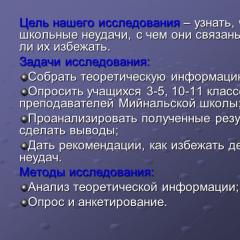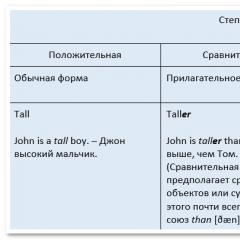Chemistry materials. Additional Chemistry Materials Chemistry Study Materials
Chemistry is one of the sciences that study nature. Or rather - elementary particles(atoms and molecules), the substances they form and the laws according to which chemical reactions take place. Historically, it turned out that the entire discipline consists of two sections: inorganic chemistry and organic. Until the end of the 18th century. these terms only meant to which kingdom of nature (animal, vegetable or mineral) the resulting compounds belong. Nose early XIX in., their meaning has changed. Now they indicate whether there is carbon in the resulting substance. Inorganic chemistry is in contact with the sciences of "inanimate" nature: geology, mineralogy, geochemistry. And organic - on the contrary, with biochemistry and biology.
For schoolchildren wishing to improve their knowledge in chemistry, it is proposed a large number of additional literature. Precisely "additional", because school textbooks have always been and will remain the main ones. All books match educational standard RF and can be used for independent work.
An example is the “Short Course in Chemistry. A guide for applicants to universities "Kuzmenko N.Ye. The book contains the fundamental fundamentals that every graduate who plans to become a chemical engineer, physician or biologist must understand. This is one of the most complete problem books in the subject, in which, moreover, a sufficient amount of theory is given.
An eye-catching book that has proven to be the most effective ways presentation of the material - illustrative and tabular. It's called All Chemistry in 50 Tables. Author - Stakheev Yu.A. The manual can be used for review in preparation for the exam. Teachers can use it to prepare handout cards for lessons. In addition to tables, the book provides information on solving the main types of problems in chemistry.
But, in order to master the technique of solving practical assignments, it is better to choose something more fundamental. For example, "1001 problems in chemistry with answers, instructions, solutions" Sleta L.А. It covers all sections of the general, organic and not organic chemistry and is suitable for both schoolchildren and students. There are two types of tasks in it: qualitative and quantitative (calculated). In addition to the tasks of the school course, the collection includes tasks regional Olympiads... The final part contains answers, detailed solutions and comments.
One more book that should definitely be remembered is “A Brief Reference to Chemistry” by OD Kurylenko. Benefit benefits of this type lies in the fact that they provide information on chemistry in a convenient laconic form, which is necessary not only for schoolchildren or students, but also for employees of the chemical industry, agriculture, laboratories, etc.
There are other useful books: “Chemistry. Textbook for universities "Nikolsky A.B.," encyclopedic Dictionary young chemist "(team of authors)," Organic chemistry. Cheat sheet "(team of authors) and others. All of them are written with one goal in mind - to help students master this exciting discipline.

2nd ed. - M .: Education, 2011 .-- 144 p.
Format: pdf
The size: 2.9 MB
drive.google
Didactic materials in chemistry for grades 10-11. A.M. Radetsky, V.P. Gorshkova, L.N. Kruglikova ( 1999 , 2nd ed., 80s.)
Format: djvu / zip (scanned a little carelessly, ends on page 75, and pages 76-77 are at the beginning, between pages 5 and 6)
The size: 65 0 Kb
/ Download file
![]()
Contents (ed. 2011, 144s.)
Foreword 3
Grade 10
Topic I. Theory chemical structure organic compounds... Electronic nature chemical bonds
Work 1. Chemical structure organic matter... Isomerism. The electronic nature of chemical bonds ... 4
Theme II. Saturated hydrocarbons (alkanes, or paraffins)
Work 1. Nomenclature and homology of alkanes 5
Job 2. Isomerism, obtaining and Chemical properties alkanes 7
Work 3. Design tasks 11
Final Work on Topic II 13
Additional tasks 15
Topic III. Unsaturated hydrocarbons (alkenes, alkadienes and alkynes)
Work 1. Nomenclature, homology and isomerism of alkenes 17
Work 2. Obtaining and chemical properties of alkenes 20
Work 3. Diene hydrocarbons. Natural rubber 21
Work 4. Acetylene hydrocarbons (alkynes) 22
Work 5. Design tasks 23
Final work on theme III 27
Additional tasks 29
Topic IV. Aromatic hydrocarbons (arenas)
Work 1. Nomenclature, isomerism and chemical properties of arenes 31
Work 2. The relationship of saturated, unsaturated and aromatic hydrocarbons 32
Work 3. Design tasks 33
Additional tasks 34
Topic V. Natural sources of hydrocarbons and their processing
Work 1. Natural sources of hydrocarbons 35
Additional tasks 36
Topic VI. Alcohols and phenols
Job 1. Limit monohydric alcohols 36
Work 2. Polyhydric alcohols and phenols 38
Work 3. Design tasks 39
Additional tasks 40
Topic VII. Aldehydes, ketones and carboxylic acids
Work 1. Aldehydes 42
Work 2. Carboxylic acids 44
Work 3. Design tasks 46
Work 4. Genetic relationship between hydrocarbons, alcohols, aldehydes and carboxylic acids 47
Work 5. Alcohols, phenols, aldehydes, carboxylic acids (experimental and computational problems) 48
Final work on themes VI, VII 50
Additional tasks 52
Topic VIII. Esters. Fats
Job 1. Esters 54
Job 2. Esters, fats 55
Work 3. Design tasks 56
Additional tasks 57
Topic IX. Carbohydrates
Work 1. Glucose, sucrose 59
Work 2. Starch, cellulose 60
Work 3. Alcohols, aldehydes, carboxylic acids, carbohydrates (experimental and computational problems) 61
Work 4. Design tasks 62
Final work on themes VIII, IX 63
Additional tasks 64
Topic X. Nitrogen-containing organic compounds
Job 1. Amines 66
Work 2. Amino acids, proteins 67
Work 3. Design tasks 68
Final work on topic X 69
Additional tasks 70
Topic XI. Synthetic polymers
Job 1. general characteristics Navy. Plastics ... 72
Job 2. Rubbers 73
Job 3. Fibers 74
Additional tasks 75
Topic XII. Generalization of knowledge on the course of organic chemistry
Work 1. Types of isomerism of organic substances 76
Work 2. Genetic relationship of organic compounds 77
Final work on the course of organic chemistry 78
Additional activities 82
Grade 11
Topic I. The most important chemical concepts and laws
Work 1. Tasks for the derivation of formulas of substances on the basis of the law of constancy of the composition of substances 83
Theme II. Periodic law and periodic table of chemical elements of D. I. Mendeleev from the point of view of the theory of the structure of atoms
Work 1. The structure of atoms and electron shells of atoms 84
Work 2. Valence possibilities of atoms.
Periodic change in the properties of chemical elements and their compounds 86
Topic III. Structure of matter
Work 1. The structure of matter 88
Work 2. Solving design problems for the preparation of solutions of various concentrations 89
Final work on themes I, II, III 91
Additional tasks 93
Topic IV. Chemical reactions
Work 1. Classification chemical reactions 95
Work 2. The rate of chemical reactions. Chemical equilibrium 96
Work 3. Electrolytes and non-electrolytes. The theory of electrolytic dissociation. Reactions in electrolyte solutions 99
Work 4. Hydrolysis of organic and inorganic compounds 101
Final work on topic IV 102
Additional tasks 105
Theme V. Metals
Work 1. Obtaining metals. Electrolysis. Corrosion of metals 109
Work 2. Metals 1A-group 111
Work 3. Metals of NA-group 112
Work 4. Aluminum and its compounds 114
Work 5. Copper, iron, chromium - metals of B-groups 115
Work 6. Metal alloys. Metal oxides and hydroxides 117
Final work on topic V 118
Additional tasks 120
Topic VI. Nonmetals
Work 1. Review of non-metals. Oxides and hydrogen compounds of non-metals 124
Work 2. Properties of oxides of non-metals. Oxygenated acids 126
Final work on topic VI 128
Additional activities 130
Final work on the course general chemistry 135
Applications 138
Summary- 1999, 2nd ed., 80 p .:
10th grade(p. 4-50)
Theme I. The theory of the chemical structure of organic compounds.
Job 1 (4 options)
Theme II. Saturated hydrocarbons (alkanes). Cycloparaffins (cycloalkanes).
Theme III. Unsaturated hydrocarbons (alkenes, alkynes).
Job 1 - Job 6 (each job contains 4 options)
Theme IV. Aromatic hydrocarbons (arenas).
Job 1 - Job 4 (each job contains 4 options)
Theme V. Alcohols and phenols.
Job 1 - Job 3 (each contains 4 options or design problems)
Theme Vi. Aldehydes and carboxylic acids.
Job 1 - Job 6 (each contains 4 options or design problems)
Theme Vii. Esters. Fats.
Job 1 - Job 2 (each job contains 4 options)
Theme VIII. Carbohydrates.
Job 1 - Job 5 (each contains 4 options or design problems)
11th grade(pp. 51-77)
Theme I. Amines. Amino acids. Nitrogen-containing heterocyclic compounds.
Job 1 - Job 4 (each job contains 4 options)
Theme II. Synthetic macromolecular substances and polymeric materials based on them.
Theme III. Generalization of knowledge on the course of organic chemistry.
Job 1 - Job 3 (4 options each)
Problems with production and interdisciplinary content (1-20)
Tasks increased complexity (1-10)
This presentation can be used in the classroom when learning new material, when repeating and generalizing the theme of the "Arena" and the entire course of organic chemistry, as well as when distance learning students. The presentation consists of 33 slides and contains full content themes, illustrations, test tasks, biography of the scientist Kekule F.A. Slide 1 Slide 5 Slide 12
This presentation can be used in chemistry lessons when learning new material (lesson 23 on thematic planning“Gara N. N. Chemistry. Lessons in grade 8 ")" Combustion and slow oxidation. The thermal effect of chemical reactions ”, with the repetition and generalization of the topic“ Oxygen ”, as well as with distance learning of students. The presentation consists of 31 slides and contains the full content of the topic, illustrations, tasks, algorithms for solving problems using thermochemical equations, reveals the basic concepts ...
Equipment: interactive whiteboard, projector, Microsoft Office Word programs. Lesson type: study new topic Forms of work: frontal, collective, individual. Annotation: open lesson on the topic “Chemical elements, their names, symbols. The Concept of Metals and Non-Metals ”with the application of Module 7 Program developed by Kazakhstani scientists jointly with the University of Cambridge. Objectives: To familiarize students with the concept of chemical element Form the ability to predict the properties of an element ...
The final lesson on the topic "Hydrocarbons" using modular technology... The material contains a summary of the lesson and a module with assignments. The abstract allows you to generalize the knowledge of students about hydrocarbons (classification, names, isomerism, problem solving, experiment). Lesson objectives: to trace the dependence of the properties of substances on the structure, to consolidate the concepts: molecular structure, type of hybridization, types of isomerism, nomenclature, properties of organic compounds, to work out the ability to apply knowledge in practice with ...
The presentation for the lesson on the topic "Hydrocarbons" contains 18 slides. The purpose of the lesson: to summarize the knowledge of students about hydrocarbons. Lesson objectives: to trace the dependence of the properties of substances on the structure, to consolidate the concepts: molecular structure, type of hybridization, homologous series, types of isomerism, nomenclature, properties of organic compounds, to work out the ability to apply knowledge in drawing up schemes of genetic communication, solving problems for the derivation of molecular formulas of organic compounds, recognition of alkanes, alkenes ...
The article provides a description of the project method, justifies the feasibility of its use in chemistry lessons and in after hours... The choice of the number of hours and the form of conducting such lessons depend on the type of project. Supposed high degree independence of students in the implementation of the project. The actualized subject knowledge in chemistry is consolidated, deepened, expanded in the process of working on a project and mastering new knowledge by students. In the classroom, it is advisable to use a different method ...
Methodical development interactive lesson chemistry in grade 9 on the topic "Reactions of ion exchange" and presentation for the lesson. Used group, individual forms of work, game moments, demonstration experiments, problematic tasks, multimedia presentation. The form of the lesson is a game-competition between the teams. This lesson can be recommended for conducting generalizing lessons on the topic, open lessons within the framework of a week or a decade of chemistry, as well as with the aim of sharing experiences ...
Here is a revised manual, which was included in the educational and methodological complex in chemistry for general education schools... Reshebnik prepared by a group of well-known specialists in the field of chemistry A.M. Radetskiy, V.P. Gorshkova. and Kruglikova L.N., will help to cope with all the tasks from didactic materials for grades 10-11.
Who do the collections with ready-made answers help:
1. first of all, students who can independently deal with incomprehensible tasks and test themselves;
2. graduates who need reference material for high-quality preparation for exams and final testing;
3. those parents who monitor the progress of their child even in graduation classes;
4. teachers, as an additional material to the class, which helps in drawing up a lesson plan.
In accordance with the original edition, the GDZ for didactic materials in grades 10-11 are divided into two large parts: the tenth and eleventh grades. The first part includes eight topics. As expected, the first topic will tell you about the basics of the subject, in particular about the theory of the chemical structure of organic compounds. And already from the second chapter, tenth graders will learn about the features of saturated hydrocarbons, this is about alkanes and cycloalkanes. The following paragraphs will deal with unsaturated hydrocarbons such as alkenes and alkynes.
The fourth chapter is devoted to arenes as aromatic hydrocarbons. Information about alcohols and phenols is found in the next chapter. The sixth chapter includes ready-made answers to tasks for aldehydes and carboxylic acids. In the seventh and eighth themes of the collection GDZ in chemistry for grades 10-11 didactic materials Radetsky schoolchildren will get acquainted with esters, and named fats and carbohydrates, respectively.
The eleventh grade of this manual is divided into only three topics. And the first broad topic includes a number of subtopics, namely: basic properties of amines; features of amino acids and nitrogen-containing heterocyclic compounds. The second is pretty complex topic about synthetic macromolecular substances and polymeric materials obtained on their basis. And at the end training course on the subject of chemistry, eleventh graders will summarize their knowledge of the course of organic chemistry and write the final test.
The authors of the reshebnik provide the correct answers to all works from the above topics of the manual. They also did not disregard tasks of increased complexity and tasks with production and inter-object content. Also, students will find solutions to additional tasks on topics. Material this collection can be used as an addition to any chemistry textbooks for high school.


